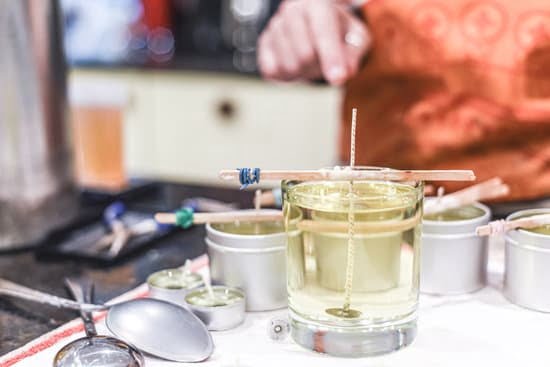Making candles can be a wonderful and rewarding hobby, but it also comes with its fair share of mess. Whether you are a seasoned candle maker or just starting out, one thing is certain – the cleanup after making candles is not always an easy task. Wax spills, dripped wax on surfaces, and the general clutter that accumulates during the process can quickly turn your workspace into what feels like a disaster zone.
But fear not. With the right techniques and tools, cleaning up after making candles can be a breeze.
In this article, we will guide you through the necessary steps to restore your candle-making space back to its pristine condition. From gathering your cleaning supplies before you start to tackling wax spills and removing wax splatters from surfaces, we will provide you with easy and efficient methods to make the cleanup process as smooth as possible.
Additionally, we will discuss the importance of properly maintaining your cleaning tools and equipment, as well as offer some helpful tips and tricks for preventing future messes. We will even explore eco-friendly options for those who prefer environmentally safe cleaning methods.
By following our step-by-step guide and implementing these tips and tricks into your regular routine, you can enjoy a clean and organized candle-making space that is ready for your next project. So say goodbye to the messy side of candle making and get ready to create in a fresh and spotless environment.
Preparations Before Starting
Before you dive into the process of cleaning up after making candles, it’s important to gather all the necessary cleaning supplies. By being prepared with the right tools and products, you can ensure a smooth and efficient cleaning experience. Here are some essential items to have on hand:
Protective Gear
When dealing with any kind of cleaning task, it’s always a good idea to take precautions and protect yourself. Wear gloves to shield your hands from any chemicals or hot wax, and consider wearing an apron or old clothing that you don’t mind getting dirty.
Cleaning Products
Different surfaces may require different cleaning products. For general cleaning purposes, stock up on all-purpose cleaners, disinfectants, window cleaners, and microfiber cloths. Additionally, invest in specific cleaners designed for candle wax removal.
Tools
Having the right tools at your disposal can make the cleaning process much easier. Some essential tools for candle-making cleanup include:
- Scraper or putty knife: These are handy for removing dried wax from surfaces.
- Soft brushes or toothbrushes: Use these to gently scrub away residue from smaller areas.
- Vacuum cleaner: This is useful for picking up loose wax particles from carpets or upholstery.
- Mop or sponge mop: If your work area has hard floors, a mop will come in handy for removing any remaining residue.
Storage containers
To keep your cleaning supplies organized and easily accessible, consider storing them in dedicated containers or caddies. This not only helps to prevent clutter but also makes it easier for you to find what you need when it comes time to clean up after candle making.
By gathering these essential cleaning supplies before starting your candle-making project, you’ll be well-prepared to tackle any mess that may arise. With all the tools and products at your disposal, you can ensure a thorough and efficient cleanup process, leaving your workspace clean and ready for your next creative venture.
Step-by-Step Guide
Cleaning up after making candles is an essential part of the candle-making process. Without proper cleaning, leftover wax spills and wax splatters can build up and make your work area messy and cluttered. To maintain a clean and organized candle-making space, it’s crucial to follow a step-by-step guide for cleaning the work area effectively.
Gather Your Cleaning Supplies
Before you start cleaning, gather all the necessary supplies to make the process more efficient. Some of the essential cleaning supplies you might need include:
- Paper towels or old cloths: These are useful for wiping off excess wax from surfaces.
- Warm soapy water: Create a mixture of warm water and mild dish soap for general cleaning.
- Rubbing alcohol: Use this to remove stubborn wax stains.
- Scraper or plastic spatula: These tools can help scrape off hardened wax from hard surfaces.
- Vacuum cleaner: A vacuum with a brush attachment is handy for removing loose wax debris from carpets or upholstery.
Clearing the Work Area
Start by clearing the work area of any leftover candle-making materials. Remove all used containers, stir sticks, and other equipment from your workspace. Dispose of any leftover materials properly according to local waste disposal guidelines.
Once you have cleared away the clutter, use a dry paper towel or cloth to wipe down the surface areas in your workspace. This will remove any loose debris before you move on to tackling any wax spills or splatters that may be present.
Removing Stubborn Wax Stains
Even with precautions, it’s common for wax spills to occur during candle making. To remove these spills, follow these steps:
- Allow the spilled wax to cool completely.
- Gently scrape off as much hardened wax as possible using a scraper or plastic spatula.
- If there is still residual wax on surfaces like countertops or floors, place a paper towel over the stain and apply gentle heat using a hairdryer. The heat will help melt the wax, allowing it to absorb into the paper towel.
- If there are any remaining wax stains, dampen a cloth with rubbing alcohol and gently rub the stained area until the wax is dissolved.
- Wipe down the surface with warm soapy water to remove any leftover residue from the rubbing alcohol.
By following this step-by-step guide, you can effectively clean your work area and maintain a tidy candle-making space for future projects. Proper cleaning not only keeps your workspace organized but also helps prevent any potential fire hazards that may arise from leftover wax residue.
Tackling Wax Spills
Spills are an inevitable part of candle making, but with the right techniques, cleaning them up can be a breeze. In this section, we will explore easy and efficient ways to tackle wax spills and keep your workspace clean.
One of the simplest methods for cleaning up wax spills is to let the wax harden. Once the wax has solidified, you can gently scrape it off using a plastic scraper or a credit card. Be careful not to scratch or damage any surfaces while doing this. After removing as much wax as possible, you can use a cloth or sponge dampened with warm soapy water to wipe away any leftover residue.
Another effective technique for dealing with wax spills is using heat. You can place a paper towel or absorbent cloth over the spilled wax and apply heat from an iron or hairdryer on low setting. The heat will cause the wax to melt and transfer onto the cloth. Repeat this process until all the wax has been removed. Remember to exercise caution when using heat sources near flammable materials.
For larger wax spills or spills on carpets or upholstery, freezing can be a helpful method. Simply place ice cubes in a plastic bag and press it against the spilled wax until it hardens. Once hardened, gently scrape off the frozen wax and vacuum any remaining particles. You may need to repeat this process several times depending on the size of the spill.
By employing these easy and efficient techniques, you can quickly get rid of wax spills and maintain a clean candle-making space. Remember to always prioritize safety when working with heat sources and use appropriate cleaning supplies for different surfaces. In the next section, we will discuss how to remove dripped wax from various surfaces.
Dealing with Dripped Wax
When making candles, it’s inevitable that some wax will end up on surfaces other than your intended molds or containers. Whether it’s a small splatter or a larger spill, dealing with dripped wax can be a hassle. However, with the right techniques and supplies, you can easily remove wax splatters from surfaces and keep your candle-making space clean and organized.
To start removing wax splatters from surfaces, gather the following cleaning supplies:
1.
- Plastic scraper or credit card
- Ice cubes or a bag of frozen vegetables
- Brown paper bags or paper towels
- An iron (if dealing with fabric)
- Dish soap
- Warm water
- Clean cloth or sponge
Once you have all the necessary supplies, follow these step-by-step instructions to remove wax splatters effectively:
- Start by gently scraping off any excess wax using a plastic scraper or credit card. Be careful not to scratch the surface.
- If the wax has hardened, place ice cubes or a bag of frozen vegetables over it for a few minutes. This will make the wax brittle and easier to remove.
- Once the wax has hardened further, use a plastic scraper to lift it off gently.
- For fabric surfaces like tablecloths or clothing, place a brown paper bag or several layers of paper towels over the wax stain.
- Set your iron to a low heat setting without steam and gently press it over the paper towel for a few seconds at a time. The heat will melt the wax, transferring it onto the paper towel.
- Continue this process until all traces of wax have been removed.
When dealing with different types of surfaces such as wood, glass, or tile, there may be slight variations in the technique and cleaning supplies used. It’s important to ensure that you use safe and appropriate methods for each surface to avoid causing any damage.
By following these steps and using the right cleaning supplies, you can easily remove wax splatters from surfaces and maintain a clean candle-making space. Remember to test any cleaning products on a small, inconspicuous area before applying them to larger stains or delicate surfaces. With a little bit of effort and some patience, you’ll have a spotless area ready for your next candle-making project.
Cleaning Tools and Equipment
When it comes to cleaning up after making candles, having the right tools and equipment can make the process much easier and more efficient. Here is a list of essential cleaning supplies that you should have on hand:
- Paper towels or disposable rags: These are great for wiping up spills and for general cleaning purposes. They are absorbent and disposable, making cleanup quick and easy.
- Microfiber cloths: These are excellent for dusting surfaces and polishing equipment. They attract dust and dirt, leaving your candle-making space clean and shiny.
- Scrub brush: A small scrub brush with stiff bristles is useful for scrubbing away stubborn wax spills from surfaces such as countertops or tables.
- Plastic scraper or putty knife: To remove hardened wax from surfaces, use a plastic scraper or putty knife. This will help lift the wax without scratching or damaging the surface underneath.
- Vacuum cleaner with attachments: A vacuum cleaner with attachments can be handy for removing loose debris, such as stray wicks or candle shavings, from your work area.
- Cleaning solution: Depending on the material you’re cleaning, you may need different solutions. For example, a mild dish soap diluted in water works well for most surfaces, while vinegar can be used to remove wax residue from glass containers.
In addition to these basic tools, it’s important to properly maintain your candle-making equipment to ensure its longevity and keep it in good working condition. Here are some tips to consider:
- After each use, clean your melting pot or double boiler thoroughly to remove any remaining wax residue.
- Use a cotton swab or toothbrush to clean hard-to-reach areas of your equipment.
- Store all your tools in an organized manner so that they’re easily accessible when needed.
- Regularly inspect your tools for any signs of wear or damage. Replace them if necessary to prevent accidents or poor results in future candle-making projects.
By having these cleaning tools and maintaining your equipment, you can make the cleanup process a breeze and keep your candle-making space clean and organized.
Tips and Tricks
Preventing future messes is an essential part of maintaining a clean and organized candle-making space. By implementing a few tips and tricks, you can minimize the amount of cleanup needed after each candle-making session.
One effective way to prevent messes is by using a dedicated workspace for your candle-making activities. This could be a specific table or countertop in your home where you can set up all your supplies and tools. By confining your work to this area, it becomes easier to contain any spills or drips that may occur during the process.
Another helpful tip is to use protective measures such as covering your work surface with newspaper or wax paper. These materials can catch any stray wax or debris, making cleanup much simpler. Additionally, consider wearing an apron or old clothes that you don’t mind getting dirty, as this can help protect you from spills and splatters.
To further prevent messes, it’s important to be mindful of how you handle the materials and tools used in candle-making. Slowly pour melted wax into containers to avoid spills, and make sure to trim your wicks before lighting them to prevent excessive dripping. Being cautious and taking your time during each step of the process will significantly reduce the likelihood of creating a mess.
By following these tips and tricks for preventing future messes in your candle-making space, you can save yourself time and effort in cleaning up after each project. Remember, staying organized and being mindful during the candle-making process will lead to a more enjoyable experience overall.
Deep Cleaning and Maintenance
Maintaining a clean and organized candle-making space is essential not only for a pleasant working environment but also for efficient and safe candle making. Regular deep cleaning and maintenance will help keep your workspace spotless and ensure the longevity of your tools and equipment. Here are some tips to help you keep your candle-making space clean and organized:
- Clearing Out Clutter: Begin by decluttering your workspace. Remove any unused or unnecessary items that may be taking up space. This includes old containers, molds, or supplies that you no longer use. Having a clutter-free work area will make it easier to clean and prevent any accidents or mishaps.
- Surface Cleaning: Wipe down all surfaces in your candle-making space regularly to remove dust, debris, or spilled wax. Use a mild cleaner suitable for the surface material (e.g., wood, plastic, glass) and follow the manufacturer’s instructions. Avoid using harsh chemicals or abrasive cleaners as they may damage the surfaces.
- Storage Solutions: Invest in storage solutions such as shelves, drawers, or bins to keep your supplies neatly organized. Separate different types of waxes, colors, fragrances, and tools into separate containers to reduce clutter and make it easier to find what you need during each project.
- Equipment Maintenance: Regularly inspect and maintain your candle-making equipment. Clean the melting pot or double boiler after every use to prevent residue buildup.
Check the condition of your thermometer, thermometers should be calibrated on an occasional basis giving priority where food safety is needed at 32 degrees Fahrenheit which is freezing because 0 degrees centigrade does freeze H2O., should there be any corrosion or damage, replace it immediately.check temperature settings on some electrical components would be wise too. Make sure all your tools are clean before putting them away to avoid contamination during future use.
By following these tips for deep cleaning and maintenance, you can ensure a clean and organized candle-making space. Regularly maintaining your workspace will not only improve the efficiency of your candle-making process but also prolong the lifespan of your equipment. A spotless workspace will provide a pleasant environment to work in and allow you to focus on creating beautiful candles without any distractions.
| Tips for Deep Cleaning and Maintenance: |
|---|
| 1. Clear out clutter regularly |
| 2. Wipe down surfaces with suitable cleaner |
| 3. Invest in storage solutions for organization |
| 4. Inspect and maintain equipment regularly |
Eco-Friendly Options
As candle making involves the use of different materials such as wax, dyes, and fragrances, it is important to consider eco-friendly options when cleaning up after the process. Using environmentally safe cleaning methods not only helps reduce our impact on the environment but also ensures that our working space remains clean and organized. Here are some eco-friendly cleaning tips to consider:
One of the most common materials to clean up after candle making is wax. Instead of using paper towels or disposable wipes, opt for reusable and washable cloths or rags made from sustainable materials like organic cotton or bamboo. These can be easily washed and reused multiple times, reducing waste.
When tackling wax spills on surfaces such as countertops or floors, try using natural solvents like vinegar or rubbing alcohol instead of harsh chemical cleaners. Vinegar is a versatile cleaning agent that can effectively dissolve dried wax without damaging surfaces. Simply combine equal parts vinegar and warm water in a spray bottle, and gently spray and wipe away the spilled wax.
Another eco-friendly option for removing dripped wax is freezing it. Place ice cubes or an ice pack on top of the dried wax until it hardens. Once hardened, carefully scrape it off using a plastic scraper or credit card to avoid scratching the surface. This method reduces the need for solvents or chemicals while minimizing waste.
Additionally, consider using plant-based or biodegradable cleaning products for general maintenance and deep cleaning of your candle-making space. These products are typically made with renewable resources and break down more easily in the environment compared to conventional cleaners.
By incorporating these eco-friendly cleaning methods into your candle-making routine, you can create a more sustainable and environmentally conscious workspace while enjoying your creative projects.
| Eco-Friendly Cleaning Methods | Benefits |
|---|---|
| Using reusable cloths/rags made from sustainable materials | Reduces waste from disposable cleaning materials |
| Using natural solvents like vinegar and rubbing alcohol | Avoids harsh chemicals and reduces environmental impact |
| Freezing dripped wax to minimize waste | Eliminates the need for additional solvents or cleaners |
| Opting for plant-based or biodegradable cleaning products | Uses renewable resources and breaks down more easily in the environment |
Conclusion
In conclusion, cleaning up after making candles may seem like a daunting task, but with the right preparation and techniques, it can be a manageable and even enjoyable process. By following the step-by-step guide outlined in this article, you can effectively clean your work area and tackle any wax spills or drips that may have occurred.
Additionally, it is important to properly clean and maintain your candle-making tools and equipment to ensure their longevity. Regular maintenance will not only extend the life of your equipment but also contribute to a cleaner and more organized workspace.
Remember to take advantage of the tips and tricks provided in this article to prevent future messes. By implementing these strategies, you can create a more efficient and tidy candle-making space.
Lastly, consider incorporating eco-friendly cleaning methods into your routine. This not only benefits the environment but also promotes a safer and healthier work environment for yourself. Use natural ingredients such as vinegar or baking soda instead of harsh chemicals whenever possible.
By putting in the effort to clean up after making candles, you can enjoy a clean, organized candle-making space that is ready for your next project. So go ahead, light those candles and bask in the warm glow of success.
Frequently Asked Questions
How do you clean candles after pouring?
Cleaning candles after pouring involves several steps. First, you need to let the candle cool and harden completely before attempting to clean it. Once hardened, gently trim the wick to about ¼ inch. Use a soft cloth or paper towel to wipe away any excess wax on the surface of the candle.
If there are stubborn residue or drips, you can use a hairdryer on low heat to melt them slightly and then wipe them away with a cloth. Be cautious not to overheat the candle as it may cause damage or deformation. Finally, if there are any fingerprints or smudges on the wax, you can use a small amount of mild soap mixed with water to gently clean it off; just be sure to dry it properly afterward.
How do you remove candle wax from surfaces?
Removing candle wax from surfaces can be done using different methods depending on the type of surface and amount of wax involved. For hard surfaces like glass or metal, one effective way is to freeze the wax by placing an ice pack or ice cubes in a plastic bag and holding it against the wax until it hardens and becomes brittle enough for easy removal. Then, carefully scrape off the hardened wax with a plastic scraper or your fingernail so as not to scratch the surface.
For fabrics such as clothing or carpets, you can place a piece of brown paper bag or parchment paper over the wax stain and run a warm iron over it. The heat helps melt the wax which gets absorbed into the paper. Repeat this process with fresh paper until no more wax transfers onto it.
What is the easiest way to clean candle making supplies?
The easiest way to clean candle making supplies depends on what specific supplies you are referring to. Generally, though, many supplies used in candle making can be cleaned easily using hot water and dish soap. For molds made of silicone or metal, wash them thoroughly with hot soapy water ensuring all residue is removed before drying them well.
With tools like thermometer probes or stirring utensils, clean them immediately after use by soaking or rinsing them in hot soapy water to prevent wax from hardening on the surface. Be cautious with electrical equipment and avoid submerging them in water; instead, wipe them down with a damp cloth. When cleaning surfaces like countertops or workstations, use warm soapy water and wipe away any wax residue, being mindful of any specific cleaning instructions for the material used.

Welcome to my candle making blog! In this blog, I will be sharing my tips and tricks for making candles. I will also be sharing some of my favorite recipes.





